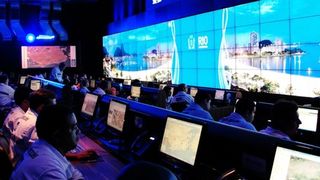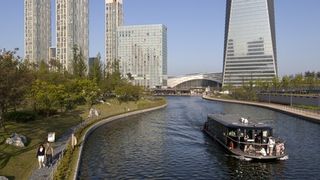How smarter cars and digital cities are about to change the way we drive
Digital communications tech is coming to a car near you

Travel and settlement has always been fuelled by the latest tech known to man. Steam power, coal, electricity and the humble combustion engine have propelled humans around cities and across the seas.
But forget fossil fuels; now it's data that's helping shape the next generation of smart cars and cities where 'intelligent mobility' is the next big thing for drivers.
Over half of all humans – 3.5 billion of us – live in cities. By 2050, that will double, which means we've got to find a way of making our cities work much more efficiently – and that means transport.
Intelligent mobility
Intelligent mobility describes any technology that increases transport network capacity while also reducing accidents and pollution. It's largely about collaboration, about creating both cars and cities that can communicate with each other, and react accordingly.
It starts with a car dashboard that knows about upcoming traffic jams in advance and automatically re-plots a route to avoid it, perhaps taking into account congestion zone charges.
And it reaches its zenith when cars automatically change speed to avoid each other, with the idea of 'platooning' when the lead car at traffic lights literally sets the exact pace of all cars behind – all networked and communicating in real-time – in an effort to get more cars through junctions as quickly as possible.
Humans losing control of their own vehicles is a distant memory in the dreams of transport planners, and while no world city is anywhere near that point, some are distinctly 'smarter' than others.
Get daily insight, inspiration and deals in your inbox
Get the hottest deals available in your inbox plus news, reviews, opinion, analysis and more from the TechRadar team.

Singapore: the smart government
An island megalopolis of five million people, wealthy Singapore is one of the world's greatest centres of capitalism. Having been in government since 1959, Singapore's ruling People's Action Party exerts unusually strong control in this former colony of the British Empire, and it's using its power to pioneer a particularly coherent, planned form of intelligent mobility.
"In Singapore, one of the most connected cities in the world, operators are investing in traffic management systems," says Macario Namie, vice president of marketing at Jasper Wireless, which provides a machine-to-machine network for Singtel in Southeast Asia. "Connectivity is impressive, not just on the mobile side, but also the fixed line. They take full advantage of their deep understanding of traffic patterns and are investing in traffic management systems, such as charge tolls based on times of traffic."

Singapore's Land Transport Authority has had a road pricing system since 1975 to control traffic flows and densities, but it's a relatively new traffic monitoring scheme called J-Eyes that has got smart city developers excited.
Junction Electronic Eyes (J-Eyes) is a network of surveillance cameras at junctions across Singapore. As of March this year there were 315 of them attached to traffic lights and lampposts, each acting as 'remote eyes' for operations executives at Singapore's traffic control centre. Video and photographs of congestion are automatically sent back to the control centre; those operations executives have so much data that they're able to re-route lanes, sending cars in specific directions to keep traffic flowing.
Just in case that seems no more than a jumped-up speed camera network, Singapore has a mature smartphone angle to its transport policy, with citizens able to download iPhone apps like TraffiCam SG, which provides real-time images from those J-Eyes cameras.

Songdo City: smart money
If Singapore is retrofitting smart driving thanks to strong, single-minded government, Songdo City near Incheon, South Korea is something of a corporate experiment. Entirely privately funded, this £20 billion project's key advantage is that it's starting from a green-field site; 1,500 acres of reclaimed land beside the Yellow Sea.
When it's completed in 2017, Songdo will be home to 65,000 residents and 300,000 workers and students will commute in each day. As well as an underground pneumatic waste collection system ridding the streets of dustbin lorries, and Cisco-provided super-fast broadband and TelePresence videoconferencing kiosks throughout (something that Cisco calls U.Life), Songdo will be fitted with subway trains, an extensive bus and cycle network, and water taxis on a central canal. Its close proximity to South Korea's main airport is causing some to call Songdo an 'aerotropolis'.
Jamie is a freelance tech, travel and space journalist based in the UK. He’s been writing regularly for Techradar since it was launched in 2008 and also writes regularly for Forbes, The Telegraph, the South China Morning Post, Sky & Telescope and the Sky At Night magazine as well as other Future titles T3, Digital Camera World, All About Space and Space.com. He also edits two of his own websites, TravGear.com and WhenIsTheNextEclipse.com that reflect his obsession with travel gear and solar eclipse travel. He is the author of A Stargazing Program For Beginners (Springer, 2015),
Most Popular


